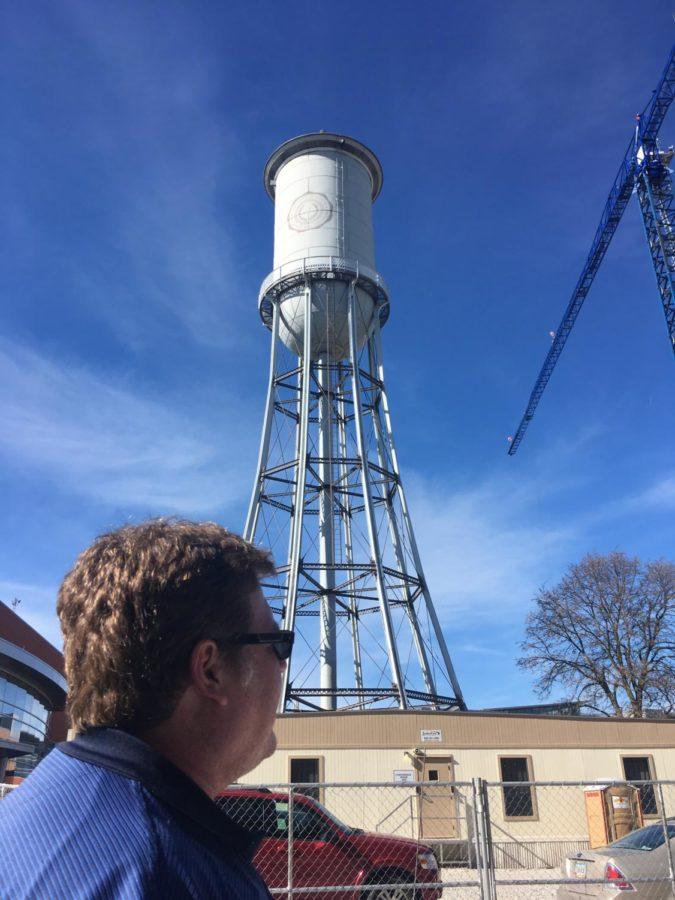Art walk celebrates discoveries and innovation in engineering at Iowa State
October 25, 2017
With over 9,669 engineering students enrolled during the fall of 2017, Iowa State’s engineering program is the 7th largest in the country. On Wednesday, University Museum’s monthly art walk highlighted the innovation and discoveries made by one of Iowa State’s oldest programs.
The walk’s first stop was at the Marston water tower. The water tower is not technically part of the Art on Campus collection, but is still a major focal point on campus.
The tower was built in 1895 after a severe water shortage forced Iowa State to cancel classes. Then dean of engineering Anson Marston wanted to propose a water tower for campus, but there were problems underlying his proposal.
“Water towers in this area were prone to rupture due to the freezing and thawing,” said David Faux, interpretations specialist for University Museums.
Marston, an engineer as well as a dean, developed a way for the water tower to avoid this issue. The Marston water tower was the tallest freestanding structure on this side of the Mississippi River at the time it was built.
Henry Brunnier was a freshman engineering student at Iowa State when the water tower was built, and he wanted to build a similar structure in his hometown of Manning, Iowa.
He asked Marston to speak to his town council, but Marston wanted Brunnier to present instead. Marston gave Brunnier the necessary information, and the town officials were convinced to build the structure. Brunnier would later go on to found his own engineering company in San Francisco, and the Brunnier Art Museum is named in his and his wife’s honor.
The next stop on the walk was a sculpture entitled “Carom” by Bruce White. Located outside of Black Engineering Building, it resides in a high traffic area, but many students don’t know the meaning of the sculpture. Even Faux, who attended Iowa State, didn’t know the history behind the piece when he was a student.
“I saw it as a really big blue thing.” Faux said. “I didn’t take the time to study it.”
White was inspired to create the sculpture when he asked engineers about what was important to their field. Materials engineers put their work under 5 foundational tests: cutting, bending, folding, nicking, and twisting. Each of these tests are represented in the sculpture.
Coover Hall, home to computer, electric, and software engineering, is home to “The Moth” by Mac Adams. Adams used negative space to create the image of a moth, but it is the viewer’s responsibility to position themselves to see the moth.
“You, as the audience, have to create the image. You have to utilize your imagination to create what the moth is,” Faux said as the attendees moved around the sculpture.
The sculpture was inspired by a story Adams heard about a moth who flew into an early model of a computer and caused the whole system to go offline. Adams loved the idea of the first “debugging” of a computer, and used the story as the primary inspiration for the work.
The walk returned to Marston Hall to observe both the exterior and interior of the building. Outside, the four muses stand on top of the building. Each muse represents one of the four original disciplines within engineering at Iowa State: mining engineering, civil engineering, mechanical engineering, and physics.
“The Fifth Muse” greets engineering students just inside the east entrance of Marston Hall. The mobile-like sculpture contains small piece of engineering materials and represents the evolution and diversity within engineering.
Faux pointed out two faces that opposed each other, and noted that Sato included this element after observing the rivalry among the many divisions of engineering. Sato also incorporated many elements from engineering labs across campus.
“Many of these pieces hanging are either ideas she stole or actual pieces she ‘stole’ from the engineering departments,” Faux said.
The goal of the art walk was not just to focus on Iowa State’s on campus art collection, but also to explore the stories behind the art. By learning about the artist’s inspirations, viewers can introduce their own perspectives when they explore a piece of art.
“I really want to encourage you and empower you to make your own interpretations,” Faux said.















